A warty chameleon digs a hole to lay her eggs
Bucket Showers and Bathroom Geckos
By Kass Wojcik
September 17, 2023
If you’ve never taken a bucket shower, I would highly recommend it. There’s just something about it that’s so much more refreshing than a “normal” shower.
Maybe it’s the physical challenge of it. You can’t just turn on a tap and there you go—you have to work for it. When I first got to camp, we had to pump our own water at a well across the road and then lug it up a hill over to the shower block before we could use it. Later when the rains came, we could use the well next to the shower block, but even then, it was still an adventure when you wanted to shower.
Or maybe it’s the mental planning and strategy involved. Am I really gross enough that I have to shower today? Is this enough water? Okay, I think I can slop about a quarter of it out of the bucket on the way up the hill and still be good. Ooo if it rains does that mean I’ll need less water? But wait, how will I ever dry then? I should leave this in the sun to warm first. What’s the optimal height and angle for pouring this to rinse my hair? How many times can I drop this soap in the dirt before I should stop using it? Am I going to run out of water before I’m done? I always felt like I had accomplished something more than simply showering by the time I went through all of that.
There was also, of course, the fact that I was showering in the open air, which really is so much better than showering indoors. The shower block in camp was walled but open to the breezy blue sky and sun-dappled trees above. Sometimes there would even be lemurs overhead, which was super cool but definitely a little violating (especially when they stare into your soul with their unnerving golden eyes before stoically pooping right over your head).
The concept of having to “work” to do something as simple as showering was something that I came across a lot in camp. I found that I had to budget more time and go through more steps to do seemingly simple tasks like brushing my teeth and packing my bag in the morning. More than once I found myself with half washed laundry as I realized that time had slipped away, and it was time to go out on survey again. It led to a slower, more relaxed existence where I felt happy simply to have clean clothes (well, about as clean as I could get them). The peaceful simplicity that I experienced in my day-to-day life in camp is something that I miss the most about my time in Madagascar.
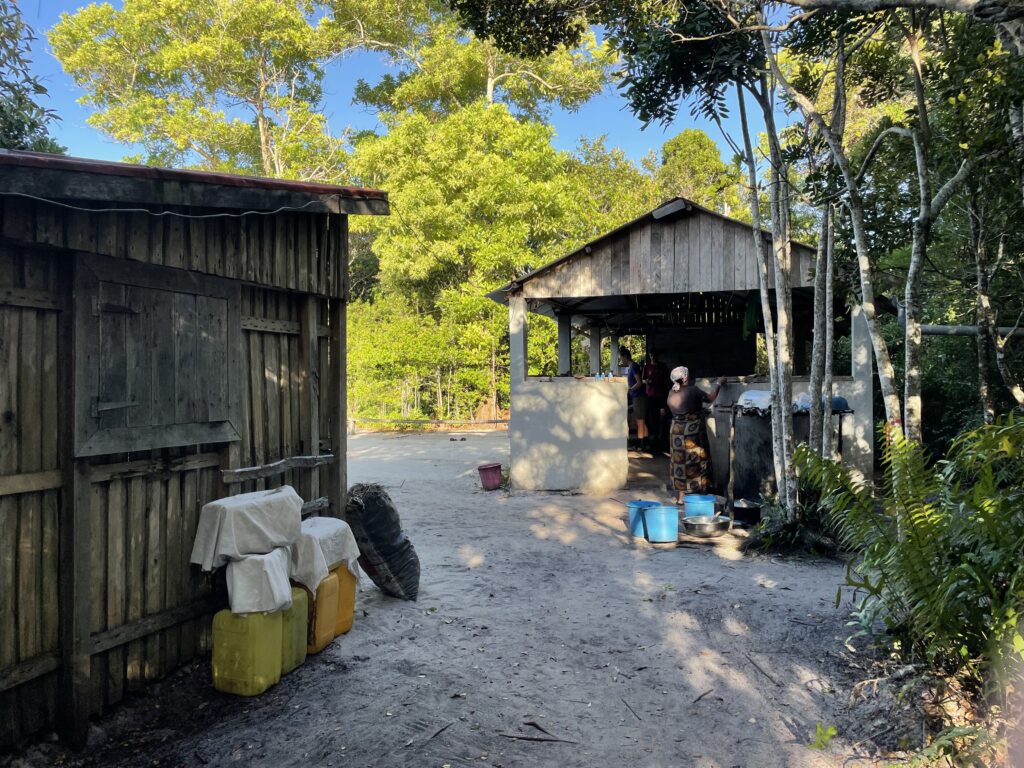
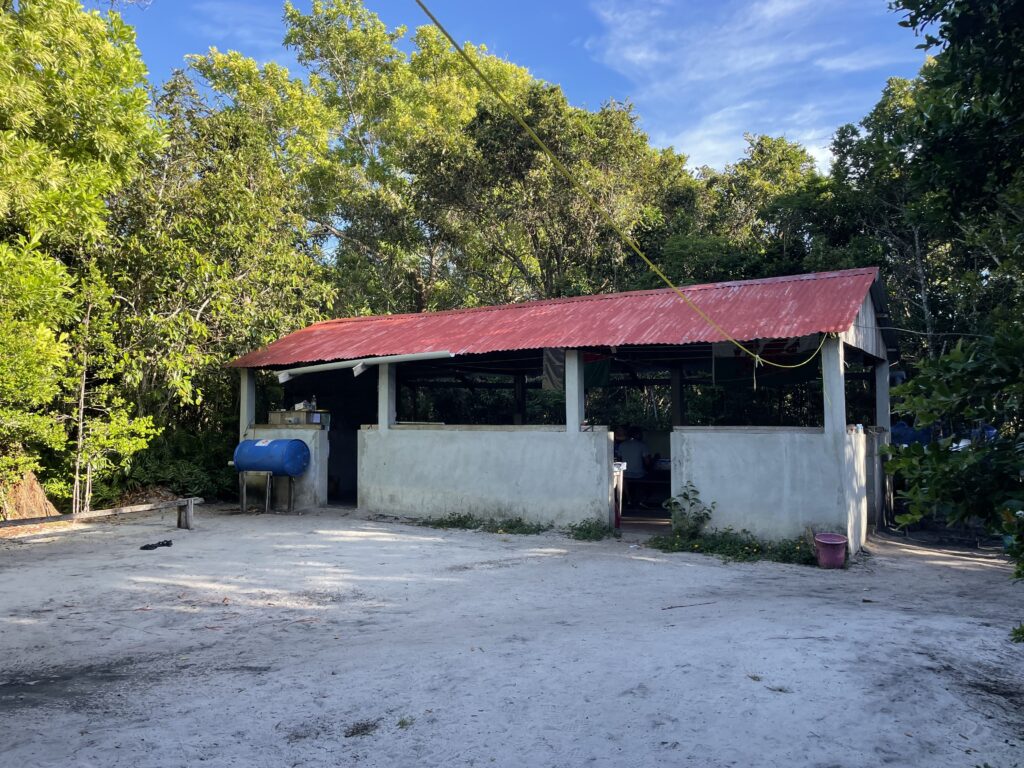
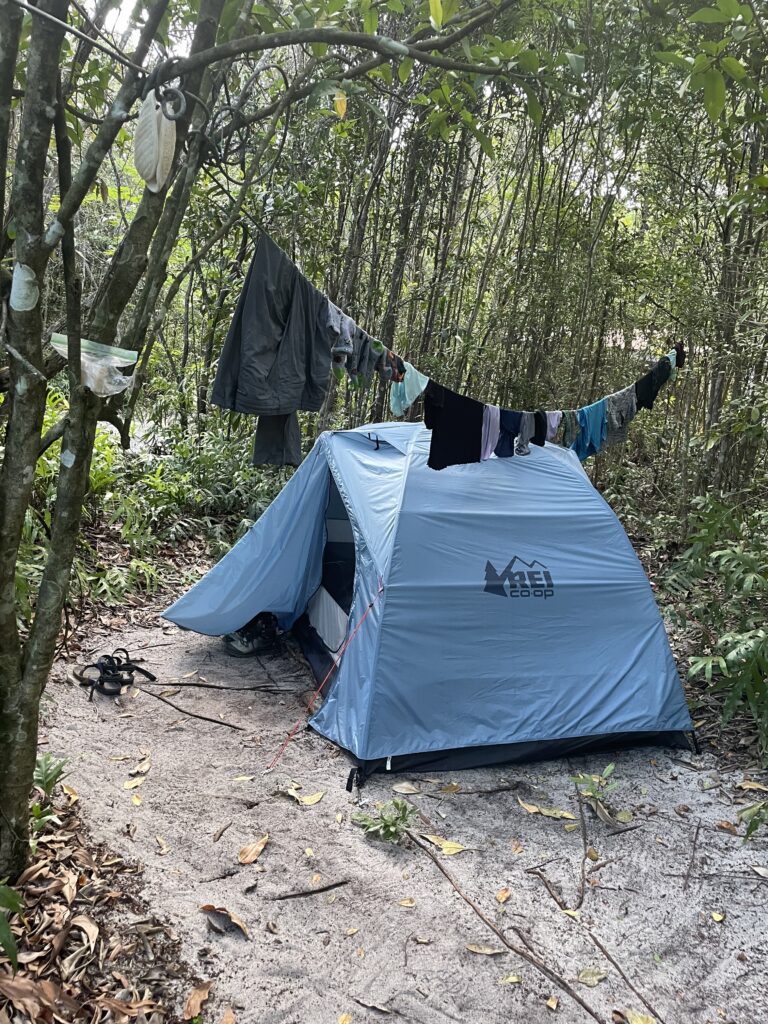
The entrance to the center of camp, the Longhouse, and my tent with half-washed laundry
My first week in the SCRP camp was all about getting to know my new surroundings and establishing somewhat of a routine, and the first step was trying to figure out how to get around camp.
It was a bit of a maze to me at first. It’s set on the edge of the S9 forest fragment in Sainte Luce and consists of a series of paths that wind through the trees. The remaining rainforest in Sainte Luce and the surrounding area is not so much one contiguous forest but a series of smaller, disjointed fragments that were assigned a letter and a number to distinguish them from one another. The S in S9 shows that the fragment is in Sainte Luce and the 9 indicates that it’s the ninth fragment. SCRP does surveys in five forest fragments in Sainte Luce and our camp was set up in the biggest of the five.
Walking into camp up the sandy path from the road, you can glimpse tents through the trees before you get to the center, which consists of three buildings in the middle of a clearing. The Longhouse is the most prominent of the three and is an open-air pavilion with a cement floor and a long table with benches down the sides where we have our meals, gather for surveys and meetings, and just generally hang out. Off to the side of it is kitchen, which is a small wooden building with a corrugated metal roof where our camp cook, Vayah, and her assistant, Solo, keep a cooking fire burning just about all day long. Across from that is a small storage building where Vaya’s cooking supplies along with some other camp staples are kept. The three buildings create a sort of sandy courtyard where bowed laundry lines hang over paths that disappear into the trees.
If you walk down the path across from the Longhouse and to the right, you’ll get to the long drop pit toilets. There are three stalls in total and they consist of a rectangular hole in the ground with two cement blocks for standing on. One of my first camp lessons was that you’re never really alone in a stall. One morning as I was walking up to the bathroom before going out on a survey, one of the researchers practically jumped out of door of the first stall. When I asked her what happened, she just gave me a tight smile and said “scorpion.” Needless to say, I used the second stall.
Though I never quite encountered a scorpion in the bathroom, I was definitely kept company by my fair share of moths, geckos, cockroaches, hand-sized spiders, snakes, and something that would make an ominous banging sound at night just in case you weren’t creeped out enough.
If you walk straight from the Longhouse instead of turning right towards the bathroom, you pass more tents before getting to the shower block, which is a row of three cement stalls open to the sky. Beyond that is one of the wells and a nursery for native plants. On the other side of the nursery is the little research center where you can do data analysis and charge things when it’s sunny, as well as Stitch Sainte Luce, one of SEED’s women’s enterprise centers where women learn to sew and market their products.
Across the road from camp is a well set in a little swamp that usually has water year-round unlike the pump in camp which only has water for a few months during and after monsoon season. Drinking water comes from a rainwater catchment and filtration system installed on the roofs of the camp buildings and the wells are used for pumping water for dishes and showering. The well water is an uncertain shade or orange-brown and has a bit of a sulfurous smell. One day a week or two after arriving, I noticed while brushing my hair that the ends seemed to be glowing a bright copper color in the sunlight. I thought that my eyes were playing tricks on me until I realized that more than just the ends had changed color. It turned out that the iron in the water had dyed my hair a rather carroty color (that I was assured was a color that lots of people would pay good money to have), and I ended up being a ginger (really more of a strawberry blonde) for most of the rest of my time in Madagascar.
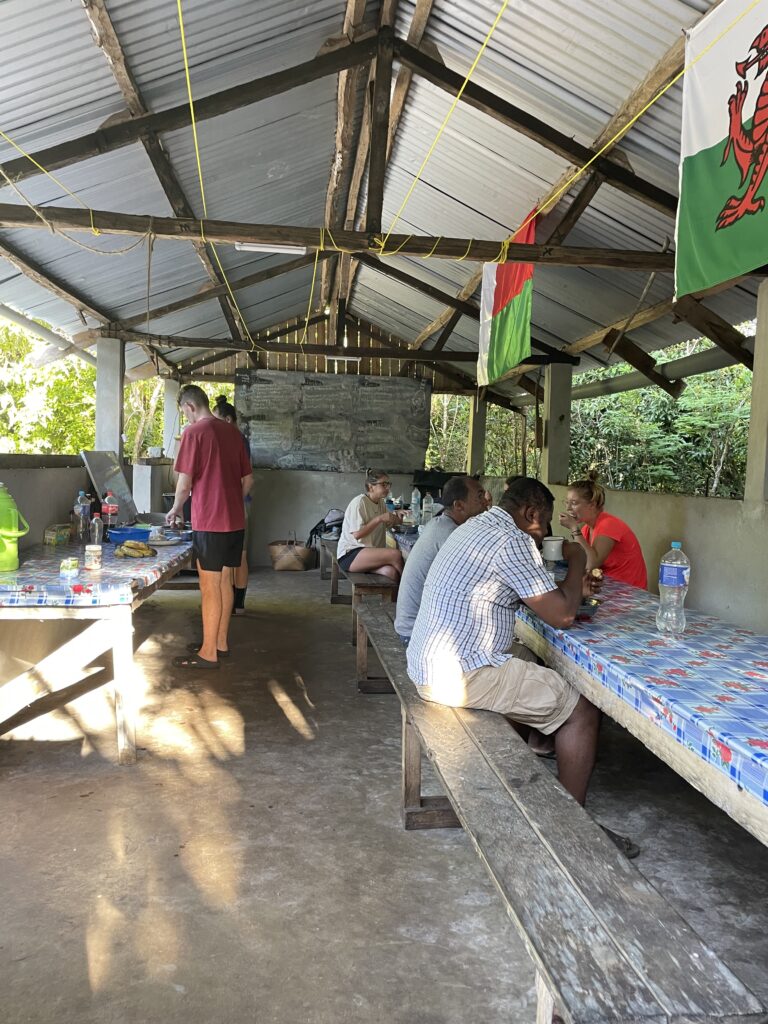
Breakfast in the Longhouse, the SCRP research center, and some zebu being herded through a pool of water followed by people transporting wood and other goods
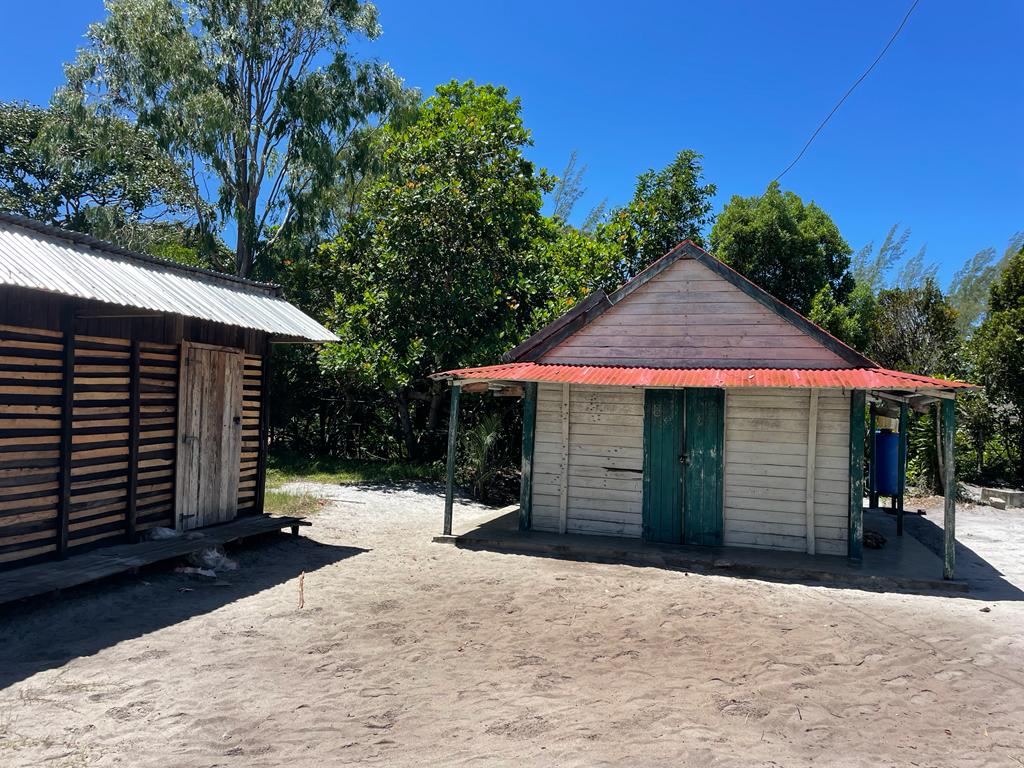
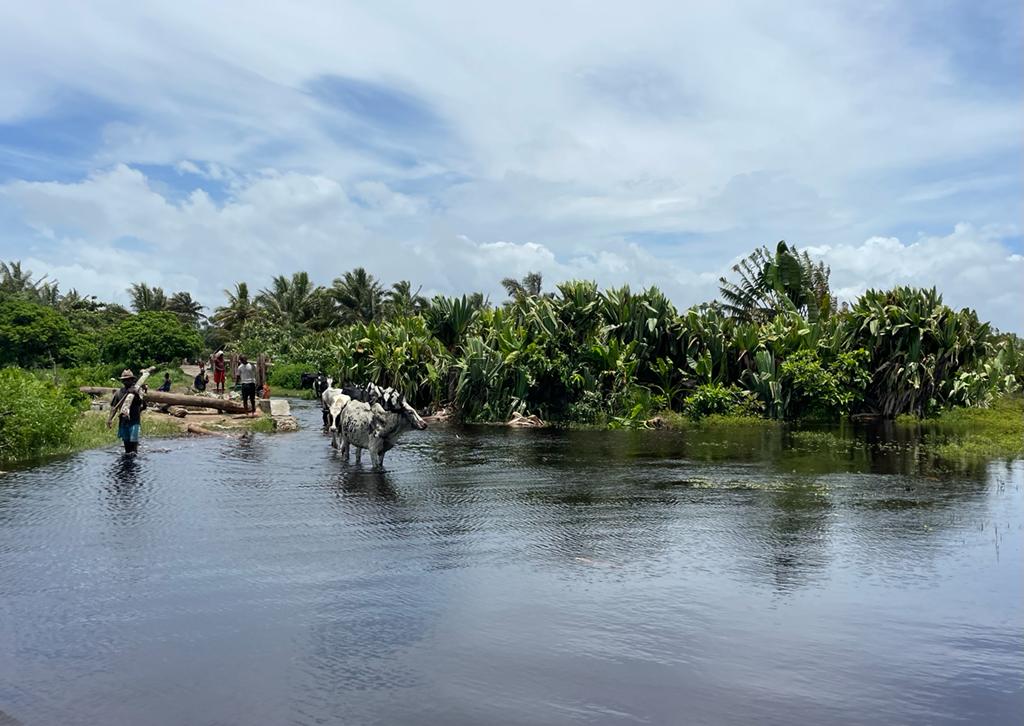
The road that we had driven down to get to camp continues another 4 km to the coast and goes through three small villages called Ambandrika, Ampanastomboky, and Manafiafy. Ambandrika is only about a five-minute walk from camp and there are a few shops where you can buy chips, biscuits, soft drinks, beer, rum, soap, washing powder, and a few other items. The shops are replenished by a supply truck that comes from Fort Duphin, but sometimes that doesn’t happen for months. Ampanastomboky and Manafiafy are a bit further away, and we would pass through them on our way to the beach or out on survey. The houses in the three villages are clustered together and usually consist of one or two rooms and are made largely of wood and palm species that provide sturdiness while also keeping the house cool (Madagascar’s national tree, Traveler’s Palm, (ravinala madagascariensis), is often used for the walls and thatching).
Most of the forest fragments we worked in were back down the road towards Fort Dauphin, and I learned this stretch of road well. Shortly after the road emerges from S9, there’s a fire break. It was set up after a fire burned part of S9 in ____ and is a bare corridor of sand between S9 and the scrubland that separates it from S8. It’s also one of two spots near camp where you can get some service. The other is a clearing behind the Longhouse where there’s a little “jungle gym” (some homemade gym equipment made by an enthusiast back in the day that’s now mostly used as places to sit while sending the odd text or email which most definitely was not the original intention) and trees where the researchers set up hammocks.
I didn’t use my phone much while in camp—or in Madagascar generally. Besides service being spotty, my data package being tiny (I had 2 GB for the whole month), and the lack of time for catching up with folks from home when they weren’t asleep or busy and I wasn’t being rained on or mosquito bitten, it felt strange to sit in the forest with birds calling and lemurs lurking overhead, chatting with people halfway around the world. Not using it led to me being more in the present, and I and didn’t spend a lot of time dwelling on the past or future or what people back home were doing without me. I found that I was more alert and immersed in what was happening around me—and there was a lot happening.
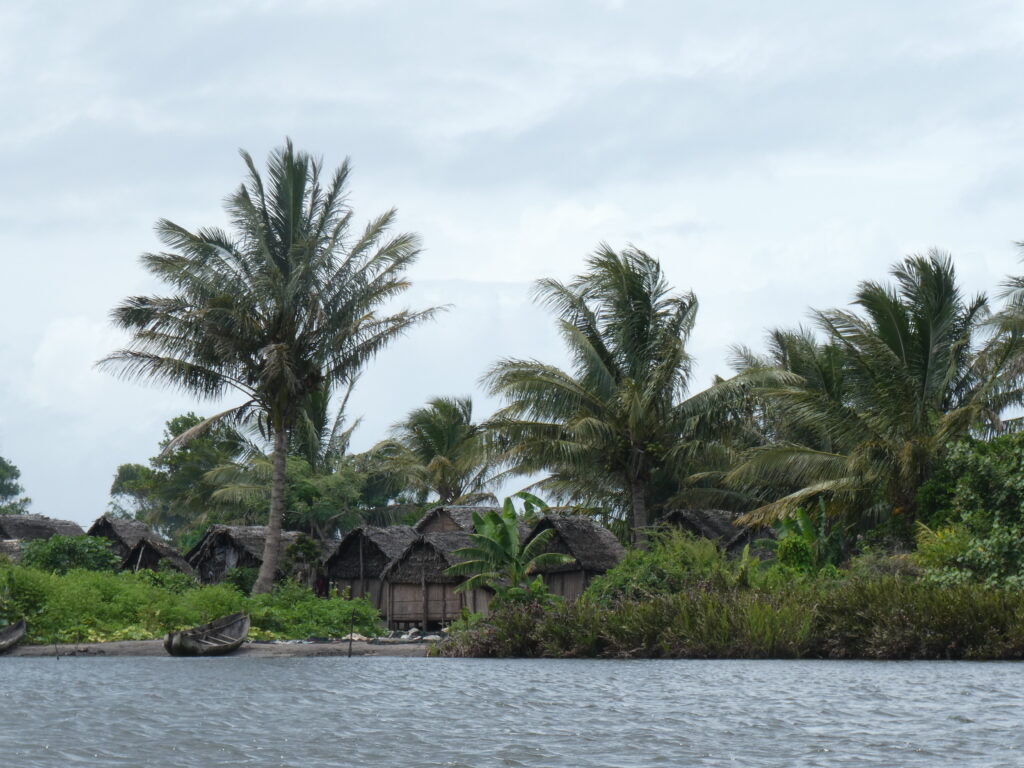
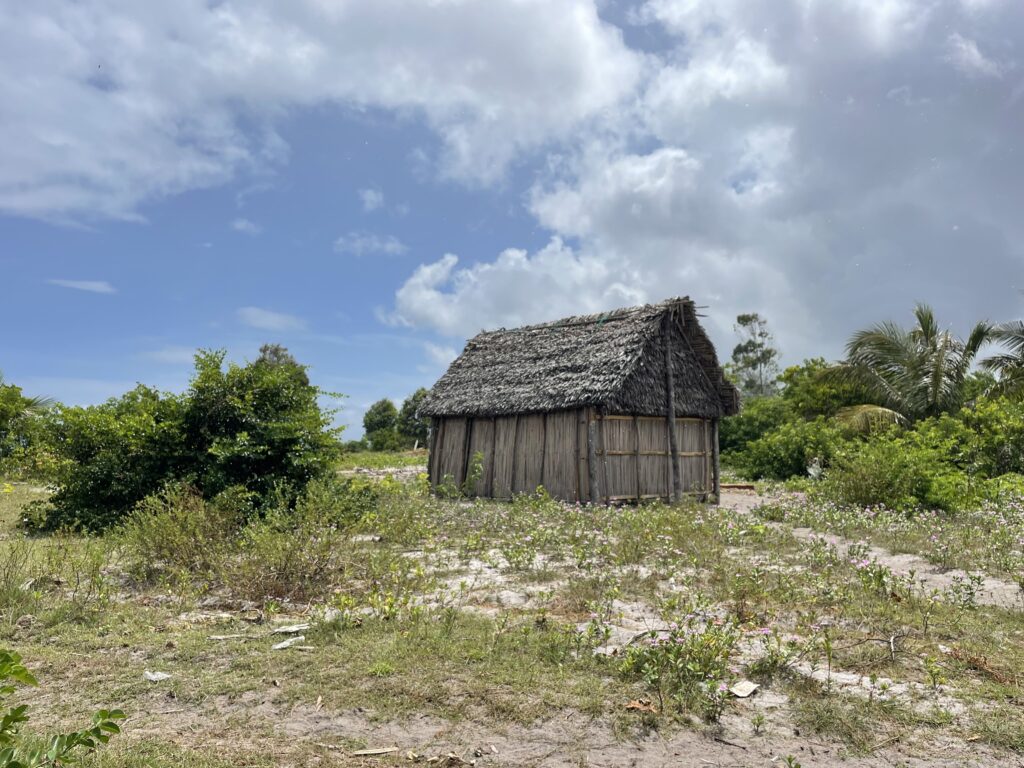
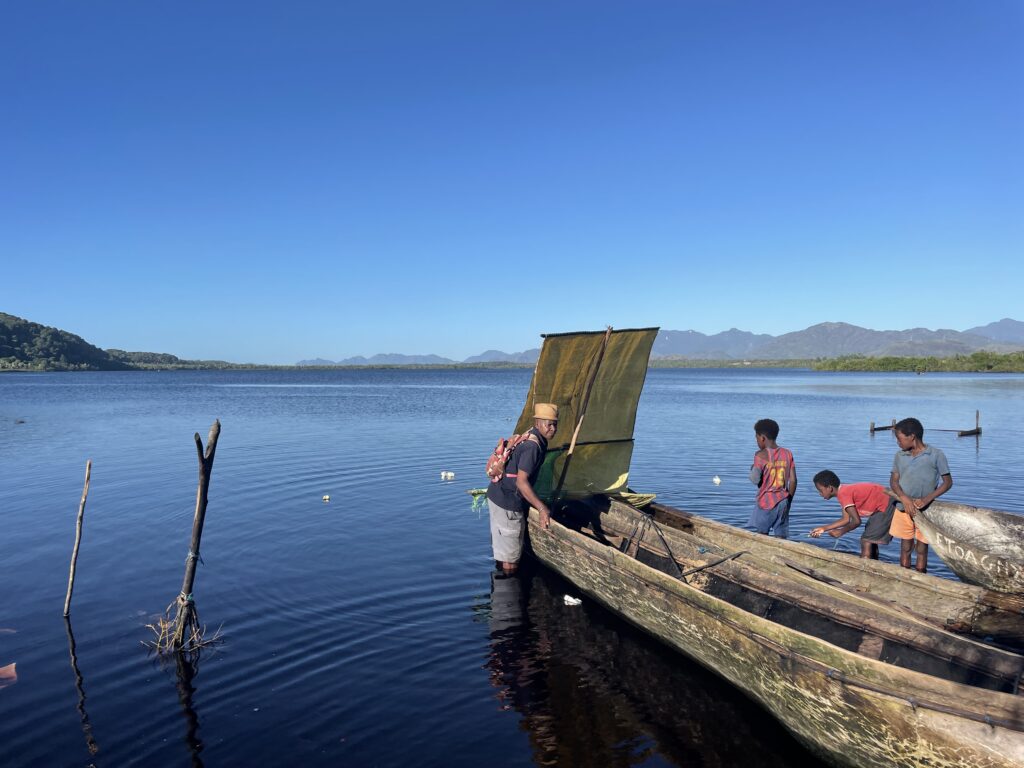
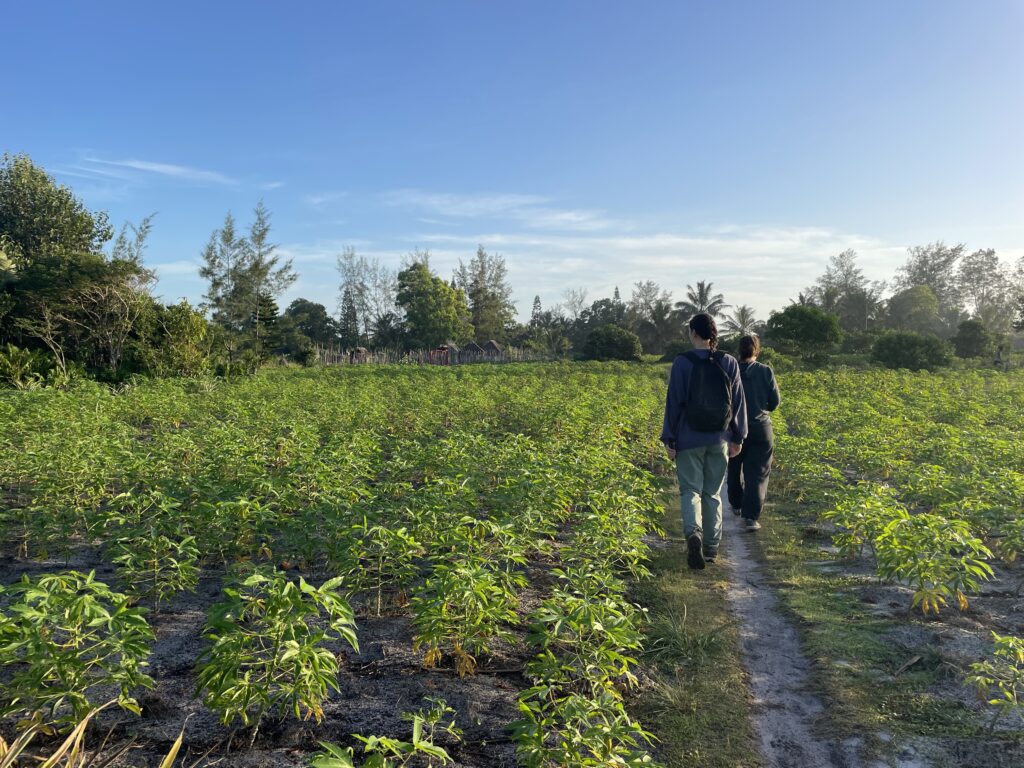
Ambandrika as viewed from the estuary in front of it; a typical house in one of the three villages; Babaly readies a pirogue for a survey while some boys crab; and Tash and Tabea walk through a field of cassava
Our days in camp are split into three time blocks. Breakfast is at 6:30 followed immediately by morning surveys. There are usually two or three happening at once, and as a volunteer, I get to pick which one I want to do. The morning surveys are usually between 3 and 5 hours and options usually include a lemur, herp (a.k.a. herpetofauna, a.k.a reptiles and), lemur, or palm tree microhabitat survey. For the lemur and herp surveys, you’re trying to spot as many as you can and record information on them in order to assess their populations. For the microhabitat survey you’re assessing the environment (e.g. light, water, soil composition, etc.) around endangered species of palm tree for future reforestation projects. The surveys are always led by at least one researcher (Hoby, Lewis, Tash, or Jas) and one guide (Solo, Raviza, or Babaly).
Lunch is at 12:00 and is usually white rice served with some kind of bean or vegetable (potatoes and carrots or pumpkin), although pasta days were also a big hit. I never knew how many different kinds of beans there are (or how delicious they can be) before camp lunches. You might not think that a hot bean stew is what you want after a long, sweaty trek through the jungle but it’s exactly what you want.
After lunch we would usually head back out at 2 once it had slightly (not really) cooled down and the nationally mandated two hour lunch break was over. After lunch is afternoon surveys. These are usually shorter (one to three hours) and is usually going out to a wetland to assess its health by doing things like water quality assessments and plant identification or doing invertebrate (animals with no backbone) surveys to see how the areas that have been reforested are doing.
Dinner was at 7 and was usually one of the dishes that wasn’t served at lunch, or as a treat a few times a week, fresh fish or chicken (fresh as in I saw the fish being brought into the village that morning and the chicken running around that afternoon). Promptly after dinner was the last (and what always felt like the longest) survey of the day which was looking for the nocturnal species of herps and lemurs.
Even though the surveys involved doing similar things every day, they were always different because we were going to different sites. SCRP’s main goals are to work with the Sainte Luce community to collect data on the species living in Sainte Luce’s ecosystems in order to find the best ways to help the community conserve and sustainably use their natural resources. The majority of this work focuses on Sainte Luce’s littoral rainforest ecosystem. A littoral rainforest is a very unique type of rainforest. They tend to receive very little rain (for a rainforest) and are located in lowland coastal zones. This means that the soil tends to be sandy, and the forest is influenced by coastal weather patterns.
